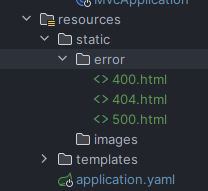10 KiB
SpringMVC笔记
- 公共AI网站:https://chatgptplus.cn/
- vue3官网:https://cn.vuejs.org/
- SpringBoot官网:https://docs.spring.io/spring-boot/index.html
访问控制
请求地址时返回对应的网页文件
@RestController用于返回对象格式的内容,在后面会使用ModelAndView可以返回网页文件@Controller用于返回网页文件
环境要求
<dependency>
<groupId>org.springframework.boot</groupId>
<artifactId>spring-boot-starter-web</artifactId>
</dependency>
<dependency>
<groupId>org.springframework.boot</groupId>
<artifactId>spring-boot-starter-test</artifactId>
<scope>test</scope>
</dependency>
<!-- thymeleaf -->
<dependency>
<groupId>org.springframework.boot</groupId>
<artifactId>spring-boot-starter-thymeleaf</artifactId>
</dependency>
<!-- devtools -->
<dependency>
<groupId>org.springframework.boot</groupId>
<artifactId>spring-boot-devtools</artifactId>
<scope>runtime</scope>
<optional>true</optional>
</dependency>
<!-- lombok -->
<dependency>
<groupId>org.projectlombok</groupId>
<artifactId>lombok</artifactId>
<version>1.18.36</version>
</dependency>
错误页面设置
在这个路径下可以配置错误码要访问的页面,也就是可以自定义页面内容
使用@Controller
返回需要访问的HTML内容页面,最后返回的字符串就是页面,这个页面位于templates目录下
@RequestMapping("/use")
@Controller
public class UseController {
// 带参数访问
@RequestMapping(value = "hello", method = RequestMethod.GET, params = {"name"})
public String hello() {
return "hello";
}
@GetMapping("jumpPage")
public String jumpPage() {
return "jumpPage";
}
@GetMapping("index")
public String quick() {
return "user";
}
// 跳转的页面
@GetMapping("toJump")
public String toJump() {
return "redirect:jumpPage";
}
}
如果在使用@Controller需要返回JSON内容,需要在控制器方法上加上@ResponseBody
@GetMapping("getJson")
@ResponseBody
public List<String> getJson() {
ArrayList<String> list = new ArrayList<>();
list.add("a");
list.add("b");
list.add("c");
return list;
}
将视图和模型拆开
// 将视图和模型拆开
@GetMapping("page/test3")
public String test3(Model model) {
model.addAttribute("test3", "测试3");
return "page/test3";
}
使用@RestController
使用方式1
如果使用@RestController那么返回的就是JSON对象,但是这时候要想返回网页文件,需要使用ModelAndView
@RequestMapping("userRest")
@RestController
public class UseRestController {
@GetMapping("page/test")
public ModelAndView test() {
ModelAndView modelAndView = new ModelAndView();
modelAndView.setViewName("page/test");
modelAndView.addObject("message", "这是消息内容");
return modelAndView;
}
}
我们引入了thymeleaf所以有以下内容<h4 th:text="'消息:'+ ${message}"></h4>
<!DOCTYPE html>
<html lang="en">
<head>
<meta charset="UTF-8">
<title>使用RestController返回页面信息</title>
</head>
<body>
<h3>使用RestController返回页面信息</h3>
<h4 th:text="'消息:'+ ${message}"></h4>
</body>
</html>
其中
modelAndView.addObject("message", "这是消息内容");是可选的
使用方式2
在控制器方法上使用ModelAndView
@GetMapping("page/test2")
public ModelAndView test2(ModelAndView modelAndView) {
modelAndView.addObject("hello", "你好");
modelAndView.setViewName("page/test2");
return modelAndView;
}
Thymeleaf快速入门
Thymeleaf 是一种现代化的 Java 模板引擎,广泛用于生成 HTML、XML、JavaScript 等内容。它有许多内置的指令和功能,用于渲染动态内容、条件渲染、循环、处理表达式等。以下是 Thymeleaf 中常见的指令和属性的详细介绍:
1. th:text
用于替换元素的文本内容。
<span th:text="${message}"></span>
${message}的值会替换span元素的文本。
如果需要格式化日期,需要注意,使用
temporals进行操作<td class="text-success" th:text="${#temporals.format(bill.transactionDate,'yyyy-MM-dd HH:mm:ss')}"></td>
2. th:utext
用于替换元素的文本内容,并允许处理 HTML 标签(不会转义 HTML)。
<span th:utext="${htmlContent}"></span>
${htmlContent}的内容直接插入,并解析其中的 HTML。
3. th:value
设置表单元素的 value 属性,通常用于输入框或选择框。
<input type="text" th:value="${user.name}" />
- 将
${user.name}的值赋给该输入框的value属性。
4. th:each
用于循环遍历集合或数组。
<ul>
<li th:each="person : ${people}">
<span th:text="${person.name}"></span>
</li>
</ul>
- 遍历
people集合,输出每个person.name。
5. th:if
用于条件渲染,只有满足条件时才渲染元素。
<div th:if="${user.isAdmin}">
<p>Welcome, admin!</p>
</div>
- 如果
user.isAdmin为true,渲染该div。
6. th:unless
与 th:if 相反,只有条件为 false 时才渲染元素。
<div th:unless="${user.isAdmin}">
<p>You are not an admin!</p>
</div>
- 如果
user.isAdmin为false,渲染该div。
7. th:attr
用于设置元素的多个属性。
<img th:attr="src=${imageUrl}" th:attr="alt=${imageDescription}" />
- 设置
img元素的src和alt属性。
8. th:src / th:href
用于动态设置 src 或 href 属性。
<img th:src="@{${imageUrl}}" alt="Image">
<a th:href="@{${linkUrl}}">Click Here</a>
th:src用于设置图片的src属性,th:href用于设置链接的href属性。
9. th:class
动态设置 class 属性,支持条件表达式。
<div th:class="${isActive} ? 'active' : 'inactive'">...</div>
- 如果
isActive为true,设置class="active",否则为inactive。
10. th:classappend / th:classprepend
分别在现有的 class 属性上追加或前置新类。
<div th:classappend="'newClass'">...</div>
<div th:classprepend="'prefixClass'">...</div>
th:classappend会将新的类追加到现有类的后面。th:classprepend会将新的类添加到现有类的前面。
11. th:id
设置元素的 id 属性。
<input type="text" th:id="${elementId}" />
- 设置
input元素的id为${elementId}的值。
12. th:action
设置表单的 action 属性。
<form th:action="@{/submitForm}" method="post">
<!-- form fields -->
</form>
- 设置表单的
action为/submitForm。
13. th:style
设置元素的 style 属性。
<div th:style="'color: ' + ${color}"></div>
- 动态设置
style属性,${color}的值会成为color样式的值。
14. th:fragment
定义一个可重用的片段,通常在模板中调用。
<div th:fragment="userFragment">
<p>Welcome, <span th:text="${user.name}"></span></p>
</div>
- 定义一个
userFragment片段,可以在其他模板中引用。
15. th:replace
替换当前元素,并将一个片段或其他模板插入其中。
<div th:replace="~{userFragment}"></div>
th:replace会将userFragment片段的内容插入到当前div中。
16. th:include
将另一个模板的内容插入当前模板中,但不会替换当前元素。
<div th:include="~{userFragment}"></div>
- 插入
userFragment的内容,但保留当前div元素。
17. th:with
局部变量声明,用于在模板中定义临时变量。
<div th:with="total=${cart.totalPrice}">
<p th:text="'Total price: ' + ${total}"></p>
</div>
th:with用于在当前元素的上下文中定义变量,类似于局部变量。
18. th:block
在模板中定义一个不会渲染任何 HTML 标签的块元素。用于组合多个元素。
<th:block th:each="person : ${people}">
<p th:text="${person.name}"></p>
</th:block>
th:block不会渲染任何标签,但可以用来包装多个元素进行条件判断或循环。
19. th:switch / th:case
类似于 Java 中的 switch 语句,用于条件选择。
<div th:switch="${status}">
<span th:case="'active'">Active</span>
<span th:case="'inactive'">Inactive</span>
<span th:case="*">Unknown</span>
</div>
- 根据
${status}的值,渲染对应的span元素。
20. th:object
用来为表单元素绑定一个对象。
<form th:action="@{/submit}" th:object="${user}">
<input type="text" th:field="*{name}" />
<input type="text" th:field="*{email}" />
<button type="submit">Submit</button>
</form>
th:object绑定整个表单到user对象。th:field用于绑定每个表单字段到对象的属性。
21. th:href / th:src
用于动态设置 URL 值。
<a th:href="@{/users/{id}(id=${user.id})}">Profile</a>
<img th:src="@{/images/{imageName}(imageName=${image.name})}" />
- 动态生成 URL,支持路径变量的替换。
22. th:placeholder
设置表单输入框的 placeholder 属性。
<input type="text" th:placeholder="${placeholderText}" />
- 设置
input的placeholder为${placeholderText}的值。
总结
Thymeleaf 提供了许多强大的指令来处理模板中的动态内容、条件渲染、迭代和属性绑定。常见的指令包括:
th:text、th:utext:用于设置文本内容。th:each:用于循环遍历。th:if、th:unless:用于条件判断。th:attr、th:id、th:class:用于设置 HTML 属性。th:replace、th:include:用于片段包含。th:switch、th:case:用于类似switch的条件语句。
